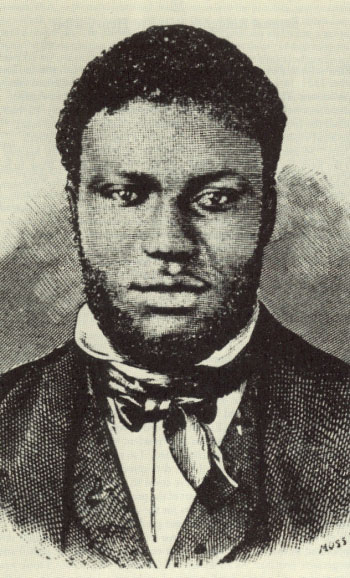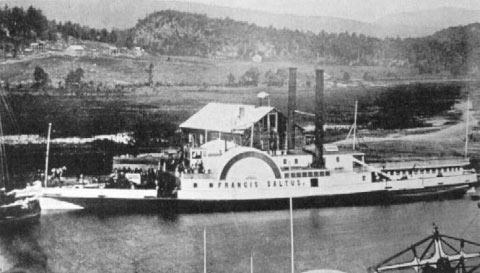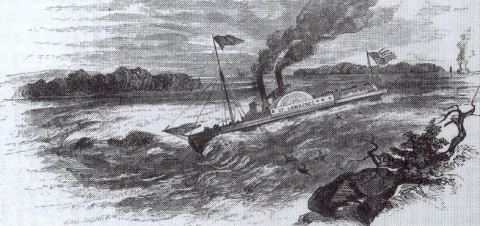The 1837 Ogdensburg Fugitive
A second early account of a fugitive from slavery who followed Lake Champlain to Canada appeared in anti-slavery newspapers in 1837. He was a man of "middle age, of noble size, six feet high...[who] made his escape from the southern States, and passed up the Champlain canal, and from Clinton county, passed through Franklin county, into the north part of St. Lawrence county, with intent to go to Ogdensburg, and cross over into Canada...." Ogdensburg was the narrowest point on the St. Lawrence River and provided easy access to refugee communities in Canada West. (See St. Lawrence County.)
Samuel R. Ward
Samuel Ringgold Ward must have been one of the most imposing men who escaped to Canada on Lake Champlain. Unlike Moses Roper, he was of unmixed African blood. He was also six and a half feet tall.
Ward's parents escaped to New Jersey from Maryland in 1820 when he was three years old. However, he did not learn he had been born into bondage until he was an adult. Fearing slave catchers, his parents moved to New York City where they raised Samuel as if he had been born free. Samuel attended the African Free School, worked as a clerk for David Ruggles (the founder of the first New York Vigilance Committee), and then became a Congregational minister. This vocation led to pastorships in Poughkeepsie and Cortland, New York, but his heart was in journalism and abolitionism.
Ward's cousin, the Rev. Henry Highland Garnet, was one the most powerful voices for black liberation in the 19th century. Both men assisted fugitive slaves on the Underground Railroad. As a traveling agent for the American Anti-Slavery Society and its New York chapter, Ward encountered opportunities to aid his oppressed race. Anti-slavery lecture tours in Eastern New York sometimes commenced in Washington County and proceeded into the northernmost counties. On one such tour in 1840, Ward accompanied New York Anti-Slavery Society Corresponding Secretary, Edward C. Pritchett, and Saratoga County abolitionist E.M.K. Glen. The men took a fugitive slave from Washington County "towards the North Star." (See Washington County.)
Samuel Ward often felt the sting of color prejudice. In 1840, he experienced a striking example of Jim Crow. While passing through the Mohawk Valley toward Binghamton, where he was scheduled to present a lecture, Ward escorted a "white lady fugitive" who was on her way to Canada. Her complexion was so fair, she was accepted by the "other" white ladies in the railroad cars from Albany to Utica and westward, and "no one suspected that she was not as respectable as the best of them!" To his irate Binghamton audience, Ward exclaimed, "I was, of course, obliged to take my seat in the negro car."
By 1851, Ward and his wife had decided to move to Canada and "purchase a little hut and garden," and pass the "remainder of their days in peace, in a free British country."
But fate intervened. On October 1, 1851, William "Jerry" Henry was arrested in Syracuse and charged with being a fugitive slave. The incident occurred just as delegates were gathering for a Liberty Party convention. Ward joined a committee to devise a plan to rescue Jerry from the city jail. He had never seen anyone in chains. He was so moved by Jerry's pitiful cries, he helped file the manacles off his body and send him to Canada.
Ward was now in danger of being arrested for violating the Fugitive Slave Act. He let his newspaper, The Impartial Citizen, breathe its last breath, and started for Canada. Following the Champlain Line of the UGRR, he took a Lake Champlain steamboat north. En route, he wrote a letter to Henry Bibb, who was publishing an abolitionist newspaper, Voice of the Fugitive, in Toronto. Bibb had escaped from slavery in 1837, but the Fugitive Slave Bill of 1850 had convinced him he had best flee from the United States. Ward informed Bibb,
...I am, like yourself, a refugee... I have come to Canada, and I am now on my way from Montreal to your part of the Province, making, or intending to make, Toronto my headquarters for the winter. I do not, of course, find Canada free from Negrophobia. As an instance of Canadian Negro hate, I took passage today, at Lachine, for Kingston. I could get a cabin passage, on the steamer St Lawrence, which carries Her Majesty's Mail, upon no terms whatever! Mr. Kelly, the Purser, declared that there was no room for me. There were half-a-dozen stateroom keys, uncalled for, in the office at the time! And the cabin saloon was much less crowded than was the deck. I concluded to sail but a short distance upon the infernal craft, but I could not have a cabin passage for over three hours! I therefore staid at this point, running the risk of finding a better chance in some other boat this evening. On Lake Champlain, the Francis Saultus [Saltus] gave me a cabin passage without hesitancy. The same is true on the Hudson River. But the St Lawrence... compels a black man to take a deck passage—or none. The boast of Englishmen, of their freedom from social negrophobia, is about as empty as the Yankee boast of democracy. I believe that a universal agitation, by the press and the tongue, in church and at the polls, will rid our beloved adopted country of this infernal curse. God forgive me when I shall refuse or neglect to do my humble part in this agitation!...Yours in exile and in hope,
S.R. Ward.
Ward had experienced color prejudice many times in the United States, and the respectful treatment he received on the Francis Saltus made a lasting impression on him.
In Montreal, Ward met with several abolitionists and the celebrated refugee, Shadrach Minkins. Shadrach had fled to Montreal from Boston by way of Vermont just eight months earlier. A vigilance committee of black men led by Lewis Hayden had rescued Shadrach from the Boston Court House. (See Canada.) Seven years earlier, Hayden had escaped from Lexington, Kentucky with the help of Rev. Calvin Fairbank and Delia Webster, a school mistress and native of Vergennes, Vermont.
A few months after Ward escaped to the Queen's Dominions, he greeted his wife and three children in their adopted country. He was outraged when his wife told him the captain of the boat on which they traveled had refused to seat them anywhere "save on the deck."
Ward became active with the Anti-Slavery Society of Canada. In 1853, the Society sent him to Great Britain. His anti-slavery lectures grew responsive crowds. In 1855, he published his life story, Autobiography of a Fugitive Negro.
From England, Ward emigrated to Jamaica, where he settled on a small piece of land he had been given while in England. He died sometime in the mid-1860s.
Frederick Douglass had high praise for Ward. He wrote, "In depth of thought, fluency of speech, readiness of wit, logical exactness, and general intelligence, Samuel R. Ward has left no successor among the colored men amongst us, and it was a sad day for our cause when he was laid low in the soil of a foreign country."
Sources:
"ANOTHER 'WHITE' LADY FUGITIVE." The Friend of Man, February 19, 1840.
Frederick Douglass, Life and Times of Frederick Douglass. Boston: De Wolfe & Fiske Co., 1892: 345. Documenting the American South. University Library, The University of North Carolina at Chapel Hill. 3 February, 2009. UNC-Chapel Hill University of North Carolina at Chapel Hill, 2001. http://docsouth.unc.edu/neh/dougl92/dougl92.html
Image of the Francis Saltus, Delaware and Hudson Champlain Transportation Company Steamship Francis Saltus. 31 March 2009. http://www.trainweb.org/dhvm/photographs/steamboats/steamboats_Francis-Saltus.htm. taken from Jim Shaughnessy, Delaware & Hudson: The History of an Important Railroad Whose Antecedent Was a Canal Network to Transport Coal(Berkeley, California: Howell-North, 1967).
Image of the St. Lawrence from W.S. Hunter, Panoramic Guide from Niagara Falls to Québec (Boston: John P. Jewett & Company, 1857).
Peter Ripley, ed., The Black Abolitionist Papers Vol 11 Canada, 1830-1865 (Chapel Hill and London: The University of North Carolina Press, 1986).
Samuel Ringgold Ward, Autobiography of a Negro His Anti-Slavery Labors in The United States, Canada & England (Chicago: Johnson Publishing Company Inc., 1970) rept. of 1855 edition by John Snow of London.









